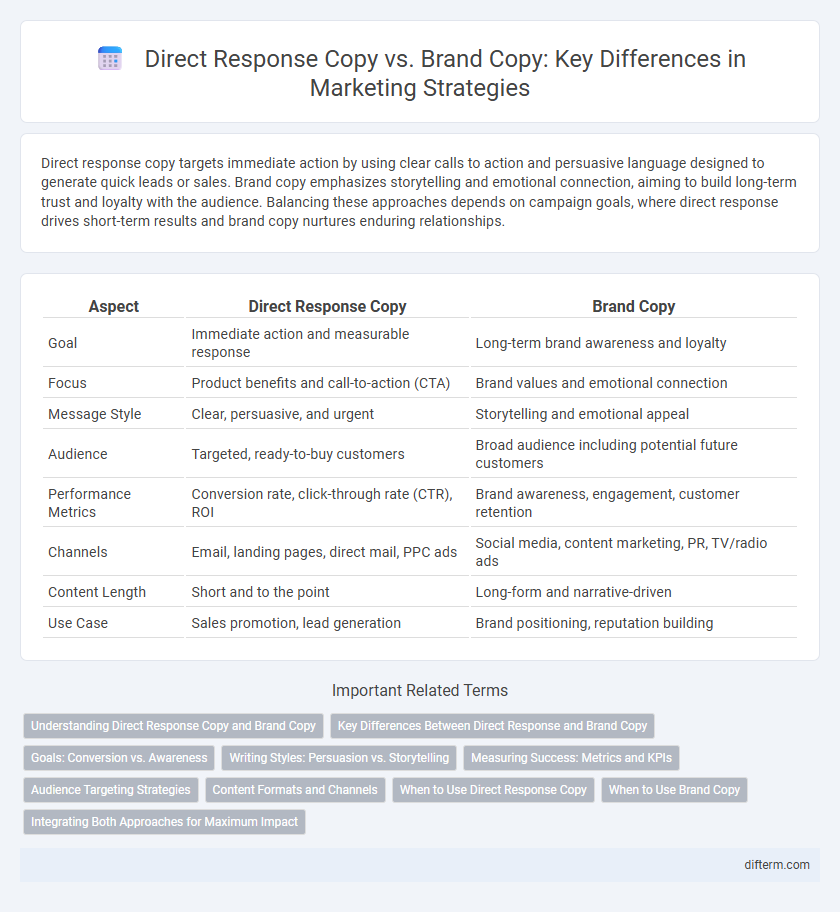Direct response copy targets immediate action by using clear calls to action and persuasive language designed to generate quick leads or sales. Brand copy emphasizes storytelling and emotional connection, aiming to build long-term trust and loyalty with the audience. Balancing these approaches depends on campaign goals, where direct response drives short-term results and brand copy nurtures enduring relationships.
Table of Comparison
| Aspect | Direct Response Copy | Brand Copy |
|---|---|---|
| Goal | Immediate action and measurable response | Long-term brand awareness and loyalty |
| Focus | Product benefits and call-to-action (CTA) | Brand values and emotional connection |
| Message Style | Clear, persuasive, and urgent | Storytelling and emotional appeal |
| Audience | Targeted, ready-to-buy customers | Broad audience including potential future customers |
| Performance Metrics | Conversion rate, click-through rate (CTR), ROI | Brand awareness, engagement, customer retention |
| Channels | Email, landing pages, direct mail, PPC ads | Social media, content marketing, PR, TV/radio ads |
| Content Length | Short and to the point | Long-form and narrative-driven |
| Use Case | Sales promotion, lead generation | Brand positioning, reputation building |
Understanding Direct Response Copy and Brand Copy
Direct Response Copy aims to generate immediate action from the audience, often using clear calls-to-action and measurable outcomes, making it highly effective for sales-driven campaigns. Brand Copy focuses on building long-term emotional connections by communicating company values, mission, and identity to create lasting brand loyalty. Understanding these distinctions helps marketers strategically choose the right approach to achieve specific business goals like conversion rates or brand awareness.
Key Differences Between Direct Response and Brand Copy
Direct Response Copy focuses on generating immediate actions by incorporating clear calls-to-action, measurable results, and urgency-driven messaging tailored to prompt conversions. Brand Copy prioritizes building long-term emotional connections and brand identity through storytelling, consistent tone, and values-driven language that fosters customer loyalty. Key differences lie in their objectives, with Direct Response aiming for quick ROI and Brand Copy emphasizing sustainable brand equity.
Goals: Conversion vs. Awareness
Direct Response Copy aims to drive immediate conversions by using clear calls to action and persuasive language that prompts the audience to make a purchase or sign up instantly. Brand Copy focuses on building long-term brand awareness and emotional connection by telling the brand's story and highlighting values without pushing for an immediate sale. Both strategies serve distinct marketing goals, with Direct Response maximizing short-term ROI and Brand Copy enhancing brand recognition and loyalty over time.
Writing Styles: Persuasion vs. Storytelling
Direct response copy prioritizes persuasive writing that drives immediate action through clear calls-to-action, urgency, and benefit-focused language designed to maximize conversions. Brand copy emphasizes storytelling, using narratives that build emotional connections and long-term brand loyalty by conveying values, personality, and customer experiences. Understanding the distinct writing styles--persuasion for direct response and storytelling for brand copy--enables marketers to tailor messages effectively to their campaign goals.
Measuring Success: Metrics and KPIs
Measuring success in direct response copy centers around metrics such as click-through rates (CTR), conversion rates, and cost per acquisition (CPA) to evaluate immediate customer actions and return on investment (ROI). Brand copy effectiveness is assessed using brand awareness, sentiment analysis, and customer lifetime value (CLV) to track long-term engagement and brand loyalty. Marketers optimize campaigns by analyzing KPIs that align with their strategic goals, ensuring direct response drives measurable transactions while brand copy builds sustained brand equity.
Audience Targeting Strategies
Direct Response Copy targets specific segments with highly personalized messages designed to provoke immediate action, leveraging data-driven insights such as demographics, psychographics, and behavioral patterns. Brand Copy focuses on broader audience appeal, building emotional connections and long-term loyalty through storytelling and consistent brand values, often using market research to define ideal customer personas. Effective audience targeting strategies balance precision in Direct Response Copy with the expansive reach of Brand Copy to optimize engagement and conversion rates.
Content Formats and Channels
Direct Response Copy thrives in formats like emails, landing pages, and social media ads designed for immediate action, leveraging strong calls-to-action and measurable outcomes. Brand Copy often appears in longer-form content such as blog posts, videos, and podcasts to build emotional connections and reinforce brand identity over time. Channels for direct response focus on high-conversion platforms like PPC ads and email marketing, while brand copy leverages broader reach through content marketing and social media storytelling.
When to Use Direct Response Copy
Direct response copy is ideal for campaigns aiming for measurable actions such as purchases, sign-ups, or inquiries, making it essential for time-sensitive promotions and product launches. It leverages clear calls to action and benefits-driven language to drive immediate consumer response and ROI. Brands seeking quick conversion and tracking effectiveness in campaigns should prioritize direct response copy over brand copy.
When to Use Brand Copy
Brand copy is ideal for building long-term customer relationships and establishing brand identity through emotional storytelling and consistent messaging. It excels in markets where trust and brand loyalty drive consumer decisions, such as luxury goods, lifestyle products, and services requiring ongoing engagement. Leveraging brand copy helps companies differentiate themselves and create lasting impressions that influence purchasing behavior over time.
Integrating Both Approaches for Maximum Impact
Combining direct response copy with brand copy amplifies marketing effectiveness by driving immediate actions while building long-term brand equity. Direct response copy's focus on clear calls-to-action complements brand copy's storytelling that fosters emotional connections and trust. Integrating both approaches creates a balanced strategy, enhancing conversion rates and reinforcing brand loyalty across customer touchpoints.
Direct Response Copy vs Brand Copy Infographic

 difterm.com
difterm.com